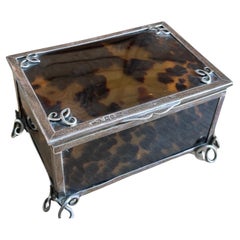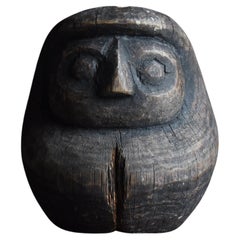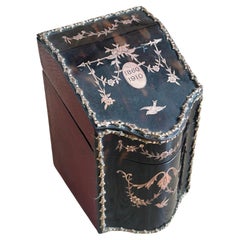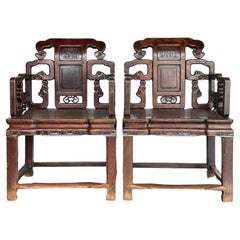Asia - Furniture
32
to
5
6,569
5,331
32
32
32
1
898
687
1,633
9,369
650
602
247
32
3
22
18
33
146
85
62
83
24
19
15
11
6
6
28
16
16
12
7
Item Ships From: Asia
Period: Early 1900s
A Pair of 19th Century Chinese Ming-style Official Hat's Chair
Located in Singapore, SG
A pair of black lacquered Ming-style official hat's chair from Shanxi province. The origin of the name is because the crest rail at the top of the chairs resembles the winged hats of...
Category
Early 1900s Chinese Qing Antique Asia - Furniture
Materials
Elm
1903 Tortoiseshell Jewellery Box with Silver Edges
By Grey & Co., Chester
Located in Hong Kong, HK
Beautiful Tortoiseshell jewellery boxes with silver Edges and curved silver cable legs
The Tortoiseshell is of light colour which enable the ...
Category
Early 1900s British Edwardian Antique Asia - Furniture
Materials
Silver
Japanese Antique Wood Carving Daruma 1900s-1920s / Sculpture Mingei Wabi Sabi
Located in Sammu-shi, Chiba
This is a very old wooden Daruma doll made in Japan.
It was made in the Meiji period (1900s-1920s).
The material is cedar wood.
This wooden model is the original Daruma doll.
Many D...
Category
Early 1900s Japanese Meiji Antique Asia - Furniture
Materials
Cedar
1906 Oval Tortoiseshell Dressing Table Box with Silver Hinges
Located in Hong Kong, HK
Very fine Tortoiseshell box, mounted with a virgin silver plaque, hallmarked silver hinges. Lined with dark blue suede. This shape indicates that this box was used to store a set of ...
Category
Early 1900s British Edwardian Antique Asia - Furniture
Materials
Silver
1905 Tortoiseshell Card Box
Located in Hong Kong, HK
Small 1905 Tortoiseshell card box, with gilded gold lining and floral decoration. The dates 1860 / 1910 are engraved on the top.
Inside the box, two compartment to fit two small card...
Category
Early 1900s British Edwardian Antique Asia - Furniture
Materials
Gold Plate
A Pair of Late Qing Large Jumu Armchairs
Located in Singapore, SG
A pair of late Qing large Jumu (southern Elm) armchairs. This type of armchairs where the chair's back, arms and seat are at 90 degrees angles to each other is commonly referred to a...
Category
Early 1900s Chinese Qing Antique Asia - Furniture
Materials
Rattan, Elm
Qing Dynasty Hand-Painted Glazed Pickling Jar, c. 1900
Located in Jimbaran, Bali
This Pickling Jar was once used to pickle eggs and features a wonderful array of hand-painted motifs which include birds, foliage and other subtle symbols and patterning. The hand-pa...
Category
Early 1900s Chinese Qing Antique Asia - Furniture
Materials
Ceramic, Paint
Early 20th Century Large Doors from Shanxi, China
Located in Singapore, SG
These large doors originated from Shanxi province, China, and are approx. 100-120 years old. Made of Elm & Pine, the most unique part about these doors are the many signs that are affixed on it, do note that although the doors are antique, these signs are added much later on.
Besides the actual door number and road name, the others are the many accolades that this family has earned. Starting from the red plate on the left, this was given by the Shanxi Provincial People's Government. The Chinese words translate into "family of glory", this was to given to the household as a member of the family had retired from the military, to recognise his contribution to the country; it could also had been given to the family if the soldier was sacrificed during his service. Next to it is a small blue plate...
Category
Early 1900s Chinese Qing Antique Asia - Furniture
Materials
Iron
Japanese Antique Deer child 1900s-1920s / Animal figurines Object Wabi Sabi
Located in Sammu-shi, Chiba
This is a very old Japanese deer figurine.
It is from the early Showa period (1900s-1920s).
It is elaborately made of paper.
The eyes seem to be made of ...
Category
Early 1900s Japanese Showa Antique Asia - Furniture
Materials
Paper
Large Teak Wood Bowl from Java, Indonesia c. 1900
Located in Jimbaran, Bali
A large teak wood bowl crafted on the island of Java, Indonesia. The bowl was cut from a much larger slab of teak wood and maintains an organic shape and ...
Category
Early 1900s Indonesian Other Antique Asia - Furniture
Materials
Teak
Bali Hindu Textile Framed 'Kamasan' Painting, Indonesia, circa 1900
Located in Jimbaran, Bali
A Mid-20th Century 'Kamasan' cotton textile painting from Bali, Indonesia. The hand painted image has great detail and depicts Balinese Hindu mythology. This textile painting is stre...
Category
Early 1900s Balinese Folk Art Antique Asia - Furniture
Materials
Cotton, Paint
Rare Ikat Textile from Timor Stunning Tribal Motifs & Colors, Indonesia c. 1900
Located in Jimbaran, Bali
An exceptionally old and fine example of a west timor ikat textile. This particular textile is incredibly old, easily over a century old with a wonderful fading of color and aging th...
Category
Early 1900s Indonesian Other Antique Asia - Furniture
Materials
Yarn
Solid Teak Sugar Cane Mill Crusher / Grinder from Java, Indonesia, c. 1900
Located in Jimbaran, Bali
This solid crusher from Java, Indonesia was part of a larger sugar cane press extracting the sugar rich juices from harvested sugar cane. Hand-crafted from teak It has beautiful wood textures. Before modern sugar cane mills...
Category
Early 1900s Indonesian Other Antique Asia - Furniture
Materials
Wood, Teak
Sculptural Teak Wood Table Hand-Hewn Detailing, Java, Indonesia, c. 1900
Located in Jimbaran, Bali
This teak coffee table was crafted on the island of Madura off the Northeastern coast of Java, Indonesia. It features angular legs that follow the curvature of each corner. A wonderf...
Category
Early 1900s Indonesian Other Antique Asia - Furniture
Materials
Teak
Meiji Period Japanese Screen Pair, One Hundred Birds by Hasegawa Gyokujun
Located in Kyoto, JP
One hundred birds
Hasegawa Gyokujun (1863-1921)
Meiji period, circa 1900.
Ink, color and gofun on silk.
Dimensions of each screen:
H. 170 cm x W. 190 cm (67’’ x 75”)
Despite the title, well over 100 birds are represented in this pair of two-fold Japanese screens (the title functions figuratively to convey the idea of a large number). The monumental work is rendered with a comprehensive and highly complex composition which is exquisitely executed and meticulously colored. More a celebration of naturalism than the traditional “One Hundred Birds” paintings which originated in China. This was a subject matter known for its auspicious meaning as much as its actual depiction of nature. These paintings generally had a phoenix (occasionally peacocks) placed in the center, and the other birds paying homage to it.
In this quintessentially Japanese scene painted by Gyokujun, a couple of long-tailed birds modeled after paradise flycatchers are included; these are traditional auspicious motifs in Oriental bird and flower painting and denote themes such as celebration and enduring generations. In addition there is the playful inclusion of single exotic parrot. Even so, the vast majority of the birds and flowers are native to Japan. Reading the scene from right to left, from spring through to autumn, the overwhelming sense is one of movement and haste. It is almost as if the birds are in a race, with the fleetest leading the way forward. Although these native birds were commonly drawn amongst artists of the Shijo school, rarely were they painted with such drama and dynamism. It is not strictly a depiction of sketched birds whose manner was faithfully handed down through the traditions of the Shijo school. Rather we see Gyokujun seeking and achieving new expressions in the heart of the turbulent Meiji period.
Hasegawa Gyokujun (1863-1921) was born in Kyoto. He was the eldest son of Hasegawa Gyokuho, a Shijo school painter who studied under Matsumura Keibun. Gyokujun studied painting under his father and became a prominent member of the Kyoto painti
ng world from a young age. In 1891 he established the ‘Young Painters Social Club’ along with Takeuchi Seiho, Miyake Gogyo and Taniguchi Kokyo. Also in 1891 he was selected as a judge of the Great Private Paintings Exhibition along with Takeuchi Seiho, Yamamoto Shunkyo...
Category
Early 1900s Japanese Meiji Antique Asia - Furniture
Materials
Silk, Wood
Terracotta Jar from Java, Indonesia c. 1900
Located in Jimbaran, Bali
A terracotta jar from the island of Java, Indonesia with an elongated spout. Jugs such as these would have been used to store, water, oil and other liquids. The age related markings ...
Category
Early 1900s Indonesian Tribal Antique Asia - Furniture
Materials
Terracotta
Solid Teak Granary Mortar from Java, Indonesia, C. 1900
Located in Jimbaran, Bali
A vintage mortar bowl soured from rural Java & crafted from a solid teak wood slab. A raw and organic object with beautiful wood textures and imperfections. A versatile decorative ob...
Category
Early 1900s Indonesian Organic Modern Antique Asia - Furniture
Materials
Teak
Solid Teak Wood Coffee Table Madura Island, Java, Indonesia, c. 1900
Located in Jimbaran, Bali
This solid teak coffee table was crafted on the island of Madura off the Northeastern coast of Java, Indonesia. It features angular legs that follow the curvature of each corner. A w...
Category
Early 1900s Indonesian Other Antique Asia - Furniture
Materials
Teak
Pair of Qing Dynasty Terracotta Pedestals
Located in Jimbaran, Bali
This pair of early 20th century Pedestals feature a wonderful age-related faded green finish. They feature a hexagonal base and largely hollow centre allowing them to remain relative...
Category
Early 1900s Chinese Qing Antique Asia - Furniture
Materials
Ceramic, Paint
Antique Primitive Pedestal Table from France
Located in Edogawa-ku Tokyo, JP
Antique Primitive three-legged wood pedestal tables from France. Can be used as side tables or plant stands. The price shown is per piece.
Only one is available.
Category
Early 1900s French Antique Asia - Furniture
Materials
Wood
Terracotta Jar from Java, Indonesia c. 1900
Located in Jimbaran, Bali
A terracotta jar from the island of Java, Indonesia with an elongated spout. Jugs such as these would have been used to store, water, oil and other liquids. The age related markings ...
Category
Early 1900s Indonesian Tribal Antique Asia - Furniture
Materials
Terracotta
Solid Teak Mortar from Java, Indonesia, C. 1900
Located in Jimbaran, Bali
A vintage mortar bowl soured from rural Java & crafted from a solid teak wood slab. A raw and organic object with beautiful wood textures and imperfections. A versatile decorative ob...
Category
Early 1900s Indonesian Organic Modern Antique Asia - Furniture
Materials
Teak
Japanese Silver Screen Pair, Meiji Period, Herons & Plovers, Shijo School
Located in Kyoto, JP
Heron & Plovers
Ink and silver leaf on paper
Maekawa Bunrei (1837-1917)
A pair of low six-panel Japanese screens by Maekawa Bunrei, a later master of the Kyoto based Shijo school of painting. On the right screen a solitary white heron stands motionless in a stream. On the left screen plovers play along a shoreline. The elegant forms are executed employing fluid, minimalistic ink brushstrokes. The soft brushstrokes and the sharp light of the silver leaf lend the scenes a sense of translucence. The sophisticated composition superbly exploits the long, horizontal pictorial surface of the pair of folding screens...
Category
Early 1900s Japanese Meiji Antique Asia - Furniture
Materials
Silver Leaf
Batik Dye Terracotta Jar from Java, Indonesia c. 1900
Located in Jimbaran, Bali
A terracotta jar from the island of Java once used for storing dyes used for crafting traditional batik textiles. The jar dates to the early 20th century. There is visible wear to th...
Category
Early 1900s Indonesian Tribal Antique Asia - Furniture
Materials
Terracotta
Solid Teak Mortar from Java, Indonesia, C. 1900
Located in Jimbaran, Bali
A vintage mortar bowl soured from rural Java & crafted from a solid teak wood slab. A raw and organic object with beautiful wood textures and imperfections. A versatile decorative ob...
Category
Early 1900s Indonesian Organic Modern Antique Asia - Furniture
Materials
Teak
Solid Teak Mortar from Java, Indonesia, C. 1900
Located in Jimbaran, Bali
A vintage mortar bowl soured from rural Java & crafted from a solid teak wood slab. A raw and organic object with beautiful wood textures and imperfections. A versatile decorative ob...
Category
Early 1900s Indonesian Organic Modern Antique Asia - Furniture
Materials
Teak
Wooden Tobacco Plantation Mini Chair, Java, Indonesia, c. 1900
Located in Jimbaran, Bali
Mini Chairs such as these were once abundant amongst Indonesian tobacco plantations for workers to sit and cut cultivated tobacco. The present mini chair is...
Category
Early 1900s Indonesian Dutch Colonial Antique Asia - Furniture
Materials
Teak
Solid Sculptural Organic Teak Stool Madura Island, Indonesia
Located in Jimbaran, Bali
This stool from the early 20th century features a beautiful wood texture and age related patina. Carved from a soild block of teak wood the stool is incredibly solid and robust. A wo...
Category
Early 1900s Indonesian Organic Modern Antique Asia - Furniture
Materials
Wood, Teak
Solid Teak Granary Mortar from Java, Indonesia, C. 1900
Located in Jimbaran, Bali
A vintage mortar bowl soured from rural Java & crafted from a solid teak wood slab. A raw and organic object with beautiful wood textures and imperfections. A versatile decorative ob...
Category
Early 1900s Indonesian Organic Modern Antique Asia - Furniture
Materials
Teak
Early 20th Century Carved Cabinet from Fujian, China
Located in Singapore, SG
An early 20th century carved 2-tier cabinet from Fujian province, China. The carvings on the front are mostly through carvings, which are carved very deep and lively, featuring human characters as well as various animals. The oval panels on the top doors are surrounded by relief carvings of phoenix...
Category
Early 1900s Chinese Qing Antique Asia - Furniture
Materials
Fir
Pair of Japanese Late Meiji Period Fukagawa Porcelain Vases, circa 1900
Located in Takarazuka, JP
Superb pair of Japanese large Meiji period Fukagawa signed porcelain vases (circa 1900). Intricately hand-painted in cobalt blue underglaze with polychrome and gold overglaze on a st...
Category
Early 1900s Japanese Meiji Antique Asia - Furniture
Materials
Gold
Late 19th Century Door Panels with Carving and Latticework
Located in Singapore, SG
Late 19th century double-width door panels from Zhejiang province, China. The framework and plain bottom panels are made of fir wood, while the latticework portion is made of Elm woo...
Category
Early 1900s Chinese Qing Antique Asia - Furniture
Materials
Elm, Fir
Recently Viewed
View AllMore Ways To Browse
Belgium Cabinet Oak
Vintage Leather Mirror
Carved Bleached Oak
Belgian Oak Cabinet
Bleached Carved Oak
Bedside Cabinets Pair Antique Furniture
Cabinets With 10 Drawers
Arch Interior Door
Wooden Door Frame
Windowed Cabinet
Burr Pair
Bronze Door Pulls
Vintage Wedding Designer
Vintage Wedding Designers
Cabinet Swedish Wood Mid Century
Bronze Door Pull
Antique Empire Desk
Asymmetric Green




